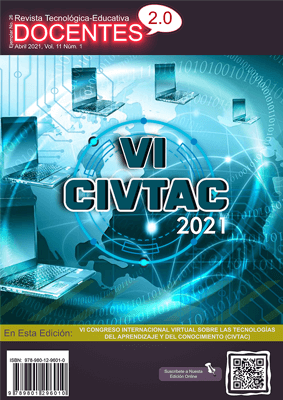Neurodidactic Teaching and Learning Strategies for Legal Research
 DOI:
https://doi.org/10.37843/rted.v11i1.142
DOI:
https://doi.org/10.37843/rted.v11i1.142
Main Article Content
Abstract
The fact that each brain is unique and points to the need to consider the diversity of students and the fact that teachers are flexible in training and evaluation processes. If all students can improve, teachers' expectations towards them must always be positive, applying strategies that develop the emotional-affective, combining with the rational, where they do not have to condition negative attitudes or past behaviors. Emotions are unconscious reactions that nature has devised to ensure survival that, for our benefit, we must learn to manage, not eradicate. Neuroscience has shown that emotions maintain curiosity; they serve both to establish communication, being essential in reasoning processes, as, in decision-making, emotional and cognitive processes are inseparable. The objective of the research was to identify neurodidactic strategies for the teaching-learning process of Legal Research in the last semesters of the Law Degree; Through Participatory Action Research applying the participant-observation method with a first strategic academic tool of diagnostic evaluation commanded by the neurodidactic way using the descriptive, developing criteria for consideration in this article that result in the following results: Student-centered methodologies, meaningful learning, linking theory with practice, and recognition of the emotional are some of the neurodidactic strategies identified.
Downloads
Metrics
Article Details

This work is licensed under a Creative Commons Attribution-NonCommercial-NoDerivatives 4.0 International License.
Those authors who have publications in our journal accept the following terms:
- When a work is accepted for publication, the author retains rights of reproduction, distribution of his/her article for exploitation in all countries of the world in the format provided by our magazine and any other magnetic medium, optical, and digital.
- Authors will retain their copyright and guarantee the journal the right first to publish their work, which will be simultaneously subject to the Creative Commons Acknowledgment License (Attribution-NonCommercial-NoDerivatives 4.0 International (CC BY-NC-ND 4.0)). That allows third parties to copy and redistribute the material in any medium or format, under the following conditions: Acknowledgment - You must properly acknowledge authorship, provide a link to the license, and indicate if any changes have been made. You may do so in any reasonable way, but not in a way that suggests you have the licensor's endorsement or receive it for your use. NonCommercial - You may not use the material for a commercial purpose. NoDerivatives - If you remix, transform, or build from the material, you cannot broadcast the modified material. There are no additional restrictions - You cannot apply legal terms or technological measures that legally restrict you from doing what the license allows.
- Authors may adopt other non-exclusive license agreements to distribute the published version of the work (e.g., deposit it in an institutional archive or publish it in a monographic volume) provided that the initial publication in this journal is indicated.
- Authors are allowed and recommended to disseminate their work through the Internet (e.g., in institutional telematic archives, repositories, libraries, or their website), producing exciting exchanges and increasing the published work's citations.
- Request of withdrawal an article has to be done in writing by the author to the Editor, becoming effective after a written response from the Editor. For this purpose, the author or authors will send correspondence via e-mail: [email protected].
- The author will not receive financial compensation for the publication of his work.
- All Docentes 2.0 Journal publications are under the Open Journal System (OJS) platform at: https://ojs.docentes20.com/.
References
Carpena C., A. (2001). Educación Socioemocionala Primaria: Materiales Prácticos de Reflexión. España: EUMO.
Díaz, P. (2018). Neuroeducación. Madrid: Telefonica.
Díaz-Barriga, F. (2010). Estrategia Docentes para un Aprendizaje Significativo. McGraw Hill.
Gardner, H. (2010). La Inteligencia Reformulada: Las inteligencias Múltiples en el siglo XXI. Paidos.
Gargallo, B., Garfella, P., Perez, C. & Fernandez, A. (2010). Modelos de enseñanza aprendizaje. Madrid: Universidad Complutense.
Guasch, O. (2002). Observación Participante. Cuadernos Metodológicos(20), 105.
Jensen, E. (2004). Cerebro y aprendizaje: Competencias e Implicaciones Educativas. http://www.ericjensen.com/
Kingsbury, L. & Hong, W. (2020). Revisión de funciones Un marco de múltiples cerebros para la interacción social. Trends in Neurosciences, 43(9), 651-666. doi:https://doi.org/10.1016/j.tins.2020.06.008 DOI: https://doi.org/10.1016/j.tins.2020.06.008
Landaeta-Mendoza, C. (2020). Gestión del Conocimiento desde una Mirada Compleja y Transdisciplinar en la Universidad Privada San Francisco de Asís –El Alto. Revista Tecnológica-Educativa Docentes 2.0, 9(2), 79-87. doi:https://doi.org/10.37843/rted.v9i2.148 DOI: https://doi.org/10.37843/rted.v9i2.148
Mujica-Sequera, R. M. (2020). La Enseñanza Tecnoemocional en la Educación del Siglo XXI. Revista Tecnológica-Educativa Docentes 2.0, 9(2), 71.78. doi:https://doi.org/10.37843/rted.v9i2.147 DOI: https://doi.org/10.37843/rted.v9i2.147
Robayo-Valle, A. (2017). La importancia del asombro en la educación para lograr aprendizajes significativos. Universidad de los Hemisferios. http://dspace.uhemisferios.edu.ec:8080/xmlui/handle/123456789/692
Salamanca, H. (2006). Introducción a la Investigación Social y Monográfica (5ta. ed.). Causa.
Soto R., M. (2016). Un Mundo Educado. http://unmundoeducado.blogspot.com/






